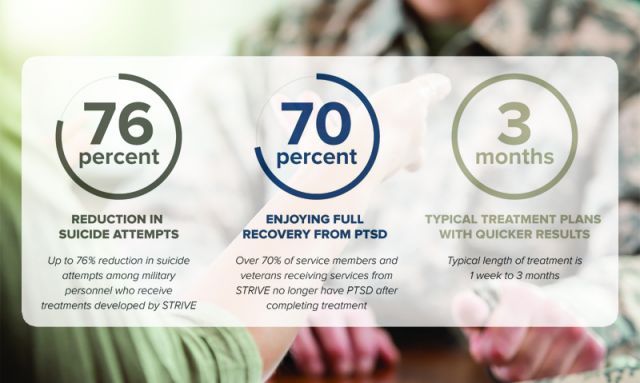
Ohio State University STRIVE program helps veterans and members of the military tackle PTSD
An active-duty member of an elite special forces team was troubled. His trauma stemmed from his experience during a brutal coup in Haiti.
The servicemember, from North Carolina, requested help from his unit’s medical officer. “Can you treat him?” the officer asked Dr. Craig Bryan, who at the time worked at the National Center for Veteran Studies at the University of Utah.
The two-week intensive trial not only helped the patient heal, but it put Craig on the path of using the therapy to treat hundreds of other veterans at Ohio State University’s STRIVE (Suicide and Trauma Reduction Initiative for Veterans).
“He was the test case and improved very fast,” says Bryan, director of Ohio State University’s Division of Recovery and Resilience and American Legion member. “That indicated this is a viable treatment. It was a medical tourism model, where you no longer have to be confined or limited to what the clinicians know in your area. You go to the clinician.”
Patients go to one-hour daily therapies for 10 straight weekdays, rather than weekly counseling sessions over months or years.
A former Air Force clinical psychologist, Bryan was drawn to the concept during his deployment to Iraq. As director of the traumatic brain injury clinic at Joint Base Balad, he saw success in daily therapy sessions with servicemembers.
At Ohio State, 90% to 95% percent of participants use virtual therapy. Whether the veteran chooses telehealth or in-person visits, the process is the same:
- The veteran completes a 30-minute online screen, answering questions about symptoms and problems.
- A psychologist conducts a phone or virtual interview, following up on the online screen and gathering information on the veteran’s history of head injuries, medical record and more.
- Next is a structured interview to confirm PTSD. “That can be challenging for some veterans, because we’re asking them questions about what happened. How has this affected your life?” Bryan says.
- Once PTSD is confirmed, a counselor contacts the veteran to schedule sessions and lay out the rules, which include a quiet, private room, and no kids, pets or other distractions.
Bryan’s team tracks the veteran’s symptoms at the start, midpoint and end. “We follow up with the veteran usually at about six and then 12 months.”
Booster sessions are available if the veteran needs additional help. The counselor reinforces the skills taught during the earlier sessions.
“The implication for veterans is profound,” Bryan says. “Think of those Vietnam vets who have struggled for decades. We’ve learned a lot from them. My hope is that in the future, we can use these more intensive, accelerated models to more rapidly help veterans recover, so they don’t have to spend decades with nightmares, isolation and anxiety.”
- Magazine

